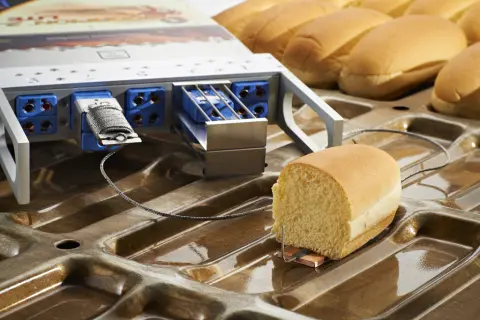From crust development to internal moisture retention, the thermal environment inside your oven plays a direct role in product quality, shelf life and process efficiency. Yet despite how important these conditions are, a surprising number of misconceptions still linger around humidity and temperature monitoring equipment for industrial bakery ovens. The experts with Reading Thermal would like to clear up some of these common misunderstandings.
Misconception #1: “Oven Setpoints Tell You Everything You Need to Know”
It’s easy to assume that if the oven control panel says it’s running at 410°F with 35 percent humidity, that’s exactly what your product is experiencing. In reality, those setpoints represent targets – not guarantees. The actual conditions can vary wildly depending on zone performance, airflow dynamics, and the physical properties of the product itself. And without the right monitoring tools, you’ll never truly know what’s happening along the belt.
Reading Thermal’s SCORPION® 2 Digital Humidity Sensor and Temperature Sensor Array gather data from the same environment your product travels through. They measure what’s actually happening – not just what the controller hopes is happening. That kind of insight can uncover hot or cold zones, reveal inconsistent moisture distribution, and help fine-tune your bake process far more effectively than relying on a static digital readout.
Misconception #2: “Humidity Doesn’t Matter in Dry Baking Applications”
Some bakeries producing crisp or dry-style baked goods assume humidity control isn’t as important because they’re not targeting a soft, moist crumb. That thinking can lead to product defects, even when the bake appears to be on target. Humidity isn’t just about moisture retention – it also affects heat transfer, surface drying, crust formation and bake time. If humidity levels are too low, you might see surface cracking, overbaked edges, or uneven color development. If it’s too high, the center might retain too much water, leading to a gummy interior.
Reading Thermal’s Humidity Sensor helps identify those imbalances before they show up on the production line. It captures both dew point and absolute humidity, which gives a more complete picture of the oven environment – especially in zones where steam injection or venting may create fluctuations. Even in so-called “dry” applications, humidity can make or break your product quality. Monitoring it closely helps you avoid costly surprises and stay consistent from batch to batch.
Misconception #3: “Monitoring Equipment Is Only Useful During Testing or Commissioning”
A lot of bakeries use humidity and temperature sensors when a new oven is installed or when launching a new product, then pack them away and move on. The assumption is that once conditions are dialed in, they’ll stay that way. But ovens aren’t static machines. Belts wear down. Burners lose efficiency. Dampers shift. Even minor changes in production volume or ingredient moisture content can throw off the balance.
Monitoring equipment like the SCORPION® 2 system isn’t just for the R&D phase. It’s a powerful tool for ongoing quality assurance. Using it regularly – whether monthly, quarterly, or after major maintenance – lets you catch problems before they spiral into full-blown inconsistencies. When your sensors are part of your routine, you can respond to subtle shifts quickly and avoid the downtime and waste that often result from unnoticed deviations.
Learn more about Reading Thermal humidity and temperature monitoring equipment for industrial bakery ovens by contacting us online or calling 610-678-5890.

